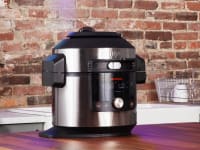Cast iron vs. stainless steel—which should you cook with when?
We compared the two of the most popular types of cookware.
Products are chosen independently by our editors. Purchases made through our links may earn us a commission.
Whether you’ve already stocked your kitchen with a carefully-selected set of cookware or you own a few ragtag cast iron and stainless steel skillets, there’s a chance you’re not using the right pans at the right time. Knowing which pieces of cookware to use when can not only add an extra flavor to your dishes, but also ensure the longevity of your beloved pans.
What should you cook on cast iron?
Although we love cast iron skillets for their versatility—they can be used on the stovetop, in the oven, or even over a campfire—they also have their limits. As cast iron is reactive with acidic ingredients, which may strip the seasoning and produce an unwanted metallic flavor, it’s best to avoid cooking acidic foods such as tomatoes and wine sauces in a cast iron pan. If you’ve accidentally cooked a tomato-based pasta sauce or shakshuka in a cast iron pan, rest assured, the unpleasant flavor won’t cause any harm to your health.
So how should you use your cast iron pan? It’s best for slow cooking, roasting, and otherwise preparing dishes that require being transferred between the oven and stovetop. I can’t tell you how much I love searing thick pieces of meat on a hot cast iron pan for a few minutes and then sliding them into the oven to slow cook. Despite its heftiness, it’s a great cooking vessel that retains heat exceptionally well, searing gourmet steaks with crispy, well-seasoned exteriors and tender, juicy interiors.
Aside from its excellent searing ability, it’s also an iconic baking tool. From classic desserts like cobblers to quick breads like Irish soda bread, cast irons can bake up grandma-style, buttery desserts with crispy edges without requiring too much baking knowledge. What’s even better is the presentation—a steaming-hot, beautiful galette in a cast iron makes the perfect centerpiece on a Sunday brunch table.
And then there’s breakfast food. As a breakfast enthusiast who loves to host, I’m obsessed with my cast iron skillet because it can cook almost everything on my breakfast menu, including eggs—as long as you follow our seasoning instructions and give your skillet proper care after each use. By correctly and regularly seasoning your skillet, you can develop a glossy patina that functions as a nonstick surface.
Another one of my cast iron breakfast favorites is Dutch baby pancakes—they’re so easy to make that I only need to toss sugar, flour, milk, and eggs in the skillet, and then let the oven finish the job.
What should you cook on stainless steel?
Popular in commercial kitchens, stainless steel cookware is fast, low-maintenance, and usually lighter than cast iron. Stainless steel pans, especially the ones with a copper core, can heat up quickly and evenly, as well as perform various cooking tasks such as searing delicate meats and sautéing. While some novice home chefs may be worried about food sticking to the pan, we actually found a good way to prevent sticking through seasoning. For home cooks, its low-maintenance requirements may also make it the perfect weeknight cooking tool.
So what can you make with a stainless steel pan? Well, let’s start with the tomato dishes and wine sauces that aren’t advisable to cook in a cast iron skillet. In my personal experience, I appreciate how convenient it is to make a pan sauce or a reduction in a stainless steel pan. And because it distributes heat more evenly than a cast iron skillet (I’ll explain in the next section), I can sear delicate meats like scallops after I preheat the pan with a few teaspoons of oil.
As the master of stir fry, my dad won’t stop raving about his stainless steel wok after he made the switch from nonstick pans. It’s significantly lighter than cast iron (so he can constantly flip the food) and capable of bringing up the heat to the optimal level (which is very high, according to Dad), guaranteeing every stir-fried dish to be crunchy and tasty.
How do cast iron and stainless steel differ in performance?
At an inexpensive price, a good cast iron pan can last you decades with proper maintenance—and American brand names such as Lodge may also come with a lifetime warranty, meaning you’ll receive a new pan if the old one cracks. A fully-clad stainless steel pan, on the other hand, is much pricier, but still durable.
While cast iron is known for its ability to retain heat, stainless steel pans are actually better at evenly distributing heat over a stovetop, according to chef and food writer Kenji Lopez-Alt. In an experiment testing various types of pans, he compared the heat conductivity of cast iron, stainless steel, and carbon steel. In the thermal images, it’s clear that the 5-ply stainless steel pan has an edge over the competition because there’s no cold spot, while the cast iron pan has a noticeable cold spot in the middle.
While the names are different, cast iron and stainless steel are both iron-carbon alloys. Each type contains a certain percentage of carbon and oftentimes other metals to achieve the desired features. In a high-quality stainless steel pan like All-Clad, chromium and copper can be layered to make it rust- and corrosion-resistant, durable, and heat-sensitive.
If you're on the hunt for new pans, we have you covered. Our testers at Reviewed ran various tests searing, braising, frying, sautéing, and making pan sauces on stainless steel and cast iron skillets to find out which ones will truly last you a lifetime.


